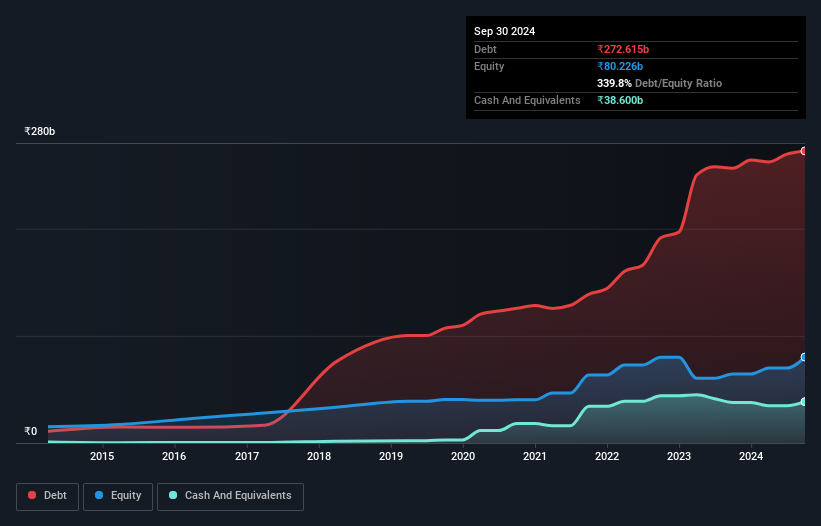Howard Marks put it nicely when he said that, rather than worrying about share price volatility, 'The possibility of permanent loss is the risk I worry about... and every practical investor I know worries about.' When we think about how risky a company is, we always like to look at its use of debt, since debt overload can lead to ruin. As with many other companies TVS Holdings Limited (NSE:TVSHLTD) makes use of debt. But the more important question is: how much risk is that debt creating?
What Risk Does Debt Bring?
Debt is a tool to help businesses grow, but if a business is incapable of paying off its lenders, then it exists at their mercy. If things get really bad, the lenders can take control of the business. While that is not too common, we often do see indebted companies permanently diluting shareholders because lenders force them to raise capital at a distressed price. Having said that, the most common situation is where a company manages its debt reasonably well - and to its own advantage. When we examine debt levels, we first consider both cash and debt levels, together.
See our latest analysis for TVS Holdings
How Much Debt Does TVS Holdings Carry?
You can click the graphic below for the historical numbers, but it shows that as of September 2024 TVS Holdings had ₹272.6b of debt, an increase on ₹256.4b, over one year. However, because it has a cash reserve of ₹38.6b, its net debt is less, at about ₹234.0b.

How Strong Is TVS Holdings' Balance Sheet?
Zooming in on the latest balance sheet data, we can see that TVS Holdings had liabilities of ₹77.4b due within 12 months and liabilities of ₹314.9b due beyond that. Offsetting these obligations, it had cash of ₹38.6b as well as receivables valued at ₹19.1b due within 12 months. So its liabilities total ₹334.7b more than the combination of its cash and short-term receivables.
This deficit casts a shadow over the ₹198.5b company, like a colossus towering over mere mortals. So we definitely think shareholders need to watch this one closely. At the end of the day, TVS Holdings would probably need a major re-capitalization if its creditors were to demand repayment. When analysing debt levels, the balance sheet is the obvious place to start. But you can't view debt in total isolation; since TVS Holdings will need earnings to service that debt. So when considering debt, it's definitely worth looking at the earnings trend. Click here for an interactive snapshot.
Over 12 months, TVS Holdings saw its revenue hold pretty steady, and it did not report positive earnings before interest and tax. While that hardly impresses, its not too bad either.
Caveat Emptor
Over the last twelve months TVS Holdings produced an earnings before interest and tax (EBIT) loss. Indeed, it lost ₹3.5b at the EBIT level. Considering that alongside the liabilities mentioned above make us nervous about the company. We'd want to see some strong near-term improvements before getting too interested in the stock. On the bright side, we note that trailing twelve month EBIT is worse than the free cash flow of ₹9.5b and the profit of ₹8.7b. So there is definitely a chance that it can improve things in the next few years. The balance sheet is clearly the area to focus on when you are analysing debt. However, not all investment risk resides within the balance sheet - far from it. We've identified 2 warning signs with TVS Holdings (at least 1 which is a bit unpleasant) , and understanding them should be part of your investment process.
Of course, if you're the type of investor who prefers buying stocks without the burden of debt, then don't hesitate to discover our exclusive list of net cash growth stocks, today.
Valuation is complex, but we're here to simplify it.
Discover if TVS Holdings might be undervalued or overvalued with our detailed analysis, featuring fair value estimates, potential risks, dividends, insider trades, and its financial condition.
Access Free AnalysisHave feedback on this article? Concerned about the content? Get in touch with us directly. Alternatively, email editorial-team (at) simplywallst.com.
This article by Simply Wall St is general in nature. We provide commentary based on historical data and analyst forecasts only using an unbiased methodology and our articles are not intended to be financial advice. It does not constitute a recommendation to buy or sell any stock, and does not take account of your objectives, or your financial situation. We aim to bring you long-term focused analysis driven by fundamental data. Note that our analysis may not factor in the latest price-sensitive company announcements or qualitative material. Simply Wall St has no position in any stocks mentioned.
About NSEI:TVSHLTD
TVS Holdings
Provides automotive vehicles and parts in India and internationally.
Solid track record, good value and pays a dividend.
Market Insights
Community Narratives



